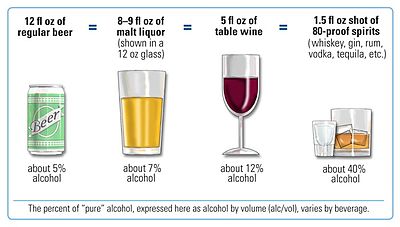Alcohol
Not all Hopkins students choose to drink. Whether or not you personally consume alcohol, it can still be helpful to understand the basics of how it works. Read on to learn more.
Standard Drink Sizes

Standard drink sizes are how someone can keep track of how much alcohol they have consumed, regardless of what they are drinking. Each type of drink contains the same amount of alcohol when using the following serving sizes:
- Beer: 12 oz (355 ml)
- Wine: 5 oz (148 ml)
- 80 Proof Liquor: 1.5 oz (44 ml)
- 100 Proof Liquor: 1 oz (30 ml)
It is important to consider how much alcohol is in each drink. For example, a standard beer contains about 5% alcohol by volume (ABV), but some craft beers can have as much as 12% alcohol by volume or more. Clearly, one 12% craft beer would have more than twice as much alcohol as a standard beer. Therefore, it should be counted as multiple standard drinks.
ABV or Proof: What’s the Difference?
Both ABV and proof are used to measure how much alcohol is in a drink. ABV stands for alcohol by volume and it is the percentage of how much pure alcohol is present in a drink. Proof, on the other hand, is written in numerals. It is twice the percentage of alcohol by volume. For example, an 80 proof vodka would contain 40% alcohol by volume. Often, you will see beer and wine labels displaying ABV and liquor labels displaying proof.
Blood Alcohol Concentration (BAC)
Blood alcohol concentration is commonly referred to as BAC and measures how much alcohol is in the body. This measurement is used to determine how drunk someone is.
While consequences can occur after any amount of alcohol consumption, keeping BAC at or below 0.055 minimizes the negative parts of alcohol use while maximizing the beneficial parts.
In Maryland, it is illegal for anyone under the age of 21 to consume alcohol. If you are under the age of 21, the driving limit is a BAC of 0.02. For those 21 or older, driving with a BAC of 0.08 or higher is illegal. Even if your BAC is below the legal limit, Health Promotion and Well-Being recommends you do not drive if you have consumed any alcohol.
What Affects BAC?
An individual’s own biology determines how their body processes alcohol. Weight, body fat percentage, and metabolism all affect how alcohol affects a body. While those factors can’t be controlled, there are ways to control your BAC.
The number of standard drinks consumed and how much time is between drinks are the two main ways to influence BAC. Other things that might change how intoxicated someone feels are tolerance, taking medication, using other drugs, hydration, and eating before starting to consume alcohol.
Consider using one of the apps listed below to keep track of your drinks and estimate your BAC.
BAC Apps for Apple
BAC Apps for Android
Signs of Alcohol Poisoning
Even though you now understand the fundamentals of alcohol and how to use standard drink sizes to maintain a BAC at or below 0.055, sometimes you or someone you know might consume too much alcohol. How can you recognize if someone has had just a little too much to drink or if their level of intoxication might warrant a trip to the hospital? Look for the following signs of alcohol poisoning:
- Vomiting
- Pale or bluish skin
- Passing out
- Low body temperature
- Slow or irregular breathing
- Confusion
- Seizures
When someone is showing these symptoms, they may be at risk of death or permanent injury. Please seek help immediately. It is important to note that someone may not show all signs and can still have alcohol poisoning. If you suspect alcohol poisoning:
- Call 911
- Stay with the person who needs help
- Cooperate with first responders and university officials
JHU has an Amnesty Protocol to prioritize your health and well-being. If someone needs medical attention for alcohol or drug consumption, they will not receive disciplinary action from the university should all of the steps be followed. The protocol also applies to individual students and Registered Groups/Organizations. Please refer to the Vice Provost for Student Affairs website for specific details and exceptions of the Amnesty Protocol.
eCHECKUP TO GO
If you would like to learn more about your alcohol use, you can use this anonymous online module to receive personalized feedback https://echeckup.sdsu.edu/usa/alc/coll/JHU.